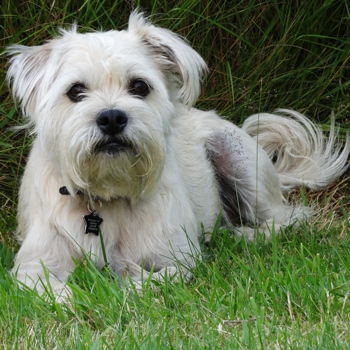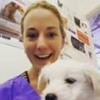Schnug

Crossing the Miniature Schnauzer with the Pug has produced a quirky looking dog with a super personality. Most have retained the classic fawn fur of the Pug with a black facial mask, though other coat colours, such as brown or black, are not uncommon. With dark eyes and a black nose, the expressive face of the Schnug has earned it a big fan base worldwide.
As the Schnug is very family-orientated, they will always be keen to be in the same room as their masters and do not appreciate being left out of the action. Those owners that work full-time or spend a lot of time away from home should consider a more independent breed.
About & History
While the Schnug may sound more like something you wear on your feet or wrap yourself up in when you’re cold at night time, this unusual word is actually the correct term for the designer dog we get when we breed the Miniature Schnauzer with the Pug. A small but spunky cross-breed, it is likely that the first Schnug was created sometime in the last two or three decades.
The Schnauzer
The Miniature Schnauzer is one variant of the three Schnauzers and is the smallest of them all. Bred within Germany in the region of Bavaria, even the Miniature version was used as an all-purpose farm dog and was made to earn their keep on the family farm. Close to the ground and speedy, these dogs excelled at vermin catching.
A ‘Utility’ type dog, the Miniature Schnauzer is the result of crossing the standard Schnauzer with the Affenpinscher and the Poodle – two popular German breeds. Having a compact version of the Schnauzer would have meant a dog that took up less space and ate less of the farmyard resources. Full of life, today’s Schnauzers are prized pets within Europe and are frequently used to compete in a number of canine sports, including agility.
The Pug
While it’s true that the Pug has enjoyed a huge surge in popularity and recognition in the last decade or so, featuring on anything from t-shirts to handbags and appearing in a number of Hollywood movies, the Pug breed is actually an ancient dog that has been around for over one thousand years. Beloved by Chinese aristocracy, they were kept as lap dogs and were exported internationally as pets over the years.
The original Pug would have been taller and would have had a larger skull as it is only quite recent breeding practices that have led to a dog with a severely brachycephalic conformation and short, stubby legs. As the health of the Pug has come under the spotlight, there has been an emerging trend to out-breed them with other, less brachycephalic breeds.
Appearance

The Schnug is quite an unusual looking dog and not one that could be called handsome in the classic sense of the word. With a relatively small skull and short muzzle, as well as large, round eyes, they have a rather unique look. Couple this with their wavy fur that can look unkempt and you have one distinctive dog. As with their parent breeds, the Schnug has triangular ears that are semi-erect, tilting forward to the side of their head. Their body is long and while their limbs are longer than those of the Pug, they could not be described as lengthy. The tail of the Schnug may be straight but often curls in over their back like that of the Pug.
The coat of the Schnug can be short or medium in length and the fur is straight. While some will retain the distinctive ‘beard and moustache’ of the Schnauzer, others will not. It is common for dogs to have a dark facial mask, or at least a darkened muzzle, although this does not hold true for all individuals. Many will have the classic fawn coloured ‘pug coat’, though their fur can also be brown, grey or black. A fully-grown Schnug will reach heights of 25cm to 36cm and weights of 7kg to 11kg, with the female often being noticeably smaller than the male.
Character & Temperament
Though the appearance of the Schnug may not appeal to everyone, their personality is practically faultless. A happy, good-natured and sweet little dog, the Schnug really does sparkle as a family pet. While they can be both curious and mischievous, they are too eager to please to ever be described as truly naughty or troublesome. Happiest when playing with their owners and in the company of children, Schnugs enjoy the company of most, though can take a short while to warm up to brand new people. As these dogs rely quite heavily on human company, they should not be expected to stay home alone all day.
Always alert and watching out for anything new that may be happening, the Schnug will immediately warn their owner of any newcomers with loud and persistent yapping. Though they will rarely act aggressive or hostile to an intruder, their incessant bark may just be enough to keep them away.
Outgoing and sociable with both people and other animals, the Schnug enjoys making doggy friends of all shapes and sizes and is often the most popular one in the dog park. While they can co-exist with cats if introduced when young, they have retained some of their prey drive and should not be expected to mingle with smaller animals, such as rabbits or gerbils.
Trainability
With levels of intelligence that are often above average, the Schnug can easily master a range of tricks and commands and makes a pleasant training partner whose enthusiasm will be immediately apparent. While the majority of dogs are easy-going, some may exhibit a stubborn streak and may require somewhat more experienced trainers to get the most out of them.
As these little dogs respond best to positive reinforcement their good behaviour should be rewarded with lots of praise, tickles and treats. It is not recommended that they be punished or reprimanded if they fail to master a command, as this can cause confusion and worry during training sessions.
Health
While it is true that out-crossing pedigree dogs can improve their health, one should not assume that the Schnug is free from all hereditary conditions. As with their parents, there are a number of health issues that can plague the Schnug and which need to be closely monitored within the population in order to control and reduce their prevalence.
Brachycephalic Upper Airway Syndrome
Though out-crossing the Pug should result in progeny that have less severe BUAS, some Schnugs will be affected. The level to which they are affected will depend on their facial shape. For some dogs, corrective surgery can help to alleviate their symptoms and allow them to live a more normal life.
Hip Dysplasia
Malformed hips can cause a great deal of discomfort during an animal’s life and hip dysplasia is not a condition that is exclusive to larger dogs. Symptoms may present as early as six months old and will gradually worsen with time as the hip joints deteriorate. This is a condition that is most commonly managed with physiotherapy, medication and exercise programmes but orthopaedic surgeries do exist that can improve the prognosis.
Diabetes
A condition whereby the blood sugar levels are consistently higher than they should be, most dogs will need daily insulin injections to control the disease. Well-managed diabetics can live relatively normal lives but do require constant monitoring and frequent veterinary check-ups.
Exercise and Activity Levels
While energetic and never lazy, the Schnug has relatively moderate exercise requirements due to its small size. A good 30 to 45 minute walk each day should be enough to keep the Schnug satisfied, as long as owners are supplementing this daily activity with other fun endeavours, such as training sessions and agility classes.
Those Schnugs who have developed the shorter snout of the Pug parent must be cautiously exercised, particularly in hot weather. As they can be prone to over-heating and may develop breathing difficulties, owners need to be acutely aware of their limitations and should alter their exercise programmes to reflect this.
There should be no issue with keeping a Schnug in an apartment as once they have received adequate exercise, they are content to stay calm and quiet within the home. Similarly, while a garden is always appreciated, it is not necessary in the case of the Schnug.
Grooming
Most breed members will need to be brushed a couple of times a week, with owners focusing on those places with longer fur, such as the face. Long beards and moustaches should be combed on a daily basis unless they are to be cut short. The ears of the Schnug should be cleared out of any wax as needed – usually every two weeks or so.

